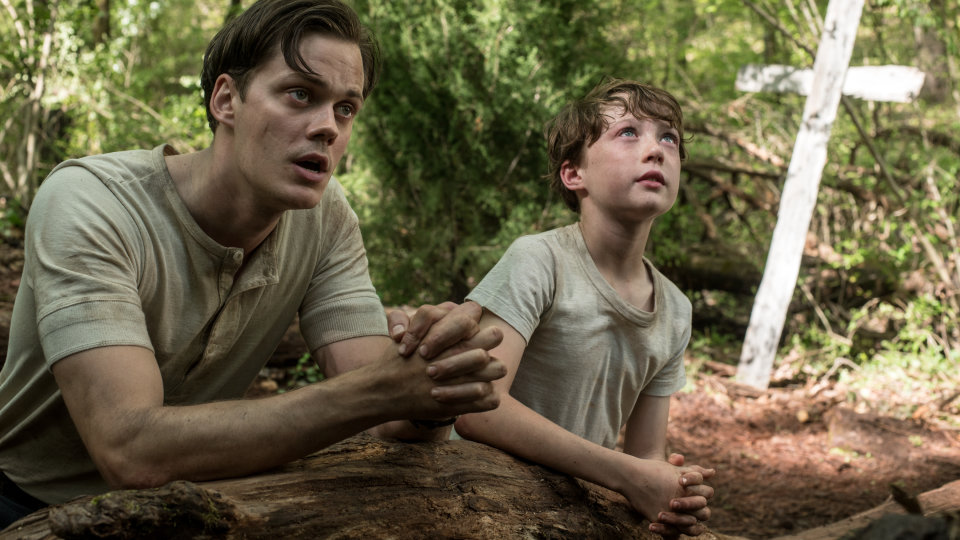 Back to selection
Back to selection
“How Much Does the Narrator Know?”: On Turning The Devil All the Time Into A Film At IFP Week 2020
 The Devil All the Time
The Devil All the Time Donald Ray Pollock was a late bloomer. It never occurred to him to become a writer, but when he was 45, having sobered up the previous decade, he had an epiphany. His dad had just retired from the same paper mill at which he worked. “I saw him go home and sit on the couch and pop a beer. And I thought, ‘That’s going to be me in another 20 years,” Pollock said. “And so I started examining what my options might be. All I knew was factory work, but I did love to read. And so I thought, ‘How hard could it be to be a writer?’ Well, a lot harder than I ever thought it would be.”
Jump some 20 years and The Devil All the Time, the first movie adaptation of his writing, has dropped on Netflix. It’s a star-studded affair, with Tom Holland as a young man growing up in a backwoods Ohio town, encountering sinister characters, such as a serial killer couple (Riley Keough and Jason Clarke), a crooked deputy (Sebastian Stan) and a lecherous preacher (Robert Pattinson) with designs on his younger sister (Eliza Scanlen). The film, directed by Antonio Campos (Afterschool, Christine), who co-wrote it with his brother Paulo, was the subject of the IFP Week 2020 panel “Thrilling on the Page and Screen,” in which the Campos brothers talked with Pollock about going to the movies.
Though he’d never been adapted for the screen before, Pollock was not hesitant to let his 2012 tome — his first novel after the short story collection Knockemstiff, named after the Ohio town in which he lives — be turned into a movie. “I always though, like a lot of writers, that the book’s the book, the movie’s the movie,” he said. “At the time I was probably thinking more about how many more copies of the book this will sell.”
One thing the Campos brothers had to consider was jettisoning the most Pollock thing of the book of all: the prose. A kind of Midwestern Gothic, it features an ensemble cast of unsavory characters, and its grisly events are spread over a couple decades. In the finished film Pollock himself reads the narration, largely directly from the book. But Antonio said the first draft of the screenplay didn’t have any voiceover — but not because they never intended to use it.
“We always had the feeling the narrator was going to come in, but we wanted to write the first draft without him to see where we needed and wanted him to appear,” Antonio said. “Once we brought the narration in it really was the final stage of writing, because it’s the final piece of the puzzle.” He and Paulo weren’t afraid of the bad reputation narration has, often seen as lazy screenwriting. In fact, they drew from an esteemed classic. “We were really inspired by the narrator of Barry Lyndon,” Antonio said, pointing to Michael Hordern’s wry and all-knowing voiceover in Stanley Kubrick’s 1975 period saga.
Pollock was always their first, and only, choice to read the narration, even though he’d never read an audio version of one of his books. In fact it was the first time they’d ever heard Pollock read his own prose aloud. “There was no one else that we ever discussed,” Antonio said. “It was like if Don said no we were going to get Sam Elliott or something. But I was very nervous to ask him. Finally I went out to Knockemstiff, and I asked him. He actually said, ‘If you don’t like it, don’t be afraid to tell me and find someone else.’ I said, ‘I think you’re fine.’”
“There wasn’t really way to imagine it without Don’s voice,” Paulo added. In the writing phase, he and Antonio had to think about the character of the narrator. “What’s his point of view? How much does the narrator know? How do you define who he is? Knowing it was coming from Don resolved any question about using a narrator in the film.”
The Devil All the Time is an unusual film to emerge in Hollywood in 2020: a long, violent movie with few heroes and an atypical story structure. No major studio would touch it — except for Netflix, which is emerging as a major studio, who will take chances on projects and filmmakers others wouldn’t, from Martin Scorsese to the late Orson Welles. Netflix wasn’t involved with the Campos’ adaptation from the start; by the time the director had a meeting with them he’d already had some of the bigger cast names, including Holland and Pattinson, as well as another key element: a look book, featuring images they planned to include in the film. “That’s important for anyone out there trying to get your script out, especially if it’s material like this that suggests a very specific visual language,” Antonio said. Along with the actors, they had a package worth pitching.
As for Pollock, the movie version of his first novel simply means he made the right decision when he was in his mid-40s, and soon thereafter when he decided to stop trying to rip off people like John Cheever and Richard Yates and instead be inspired by one of Gothic literature’s titans, Flannery O’Connor. “I began typing out other people’s stories. And Flannery O’Connor was one of the first ones I started typing out,” Pollock said. He wrote a story he admits isn’t great, but it inspired him to write not about the East Coast but about his neck of woods. “I don’t know anything about suburbanites and doctors and lawyers and all that. I know about the people around here. Mostly poor people and blue collar people. I decided to stick with what I knew.”
